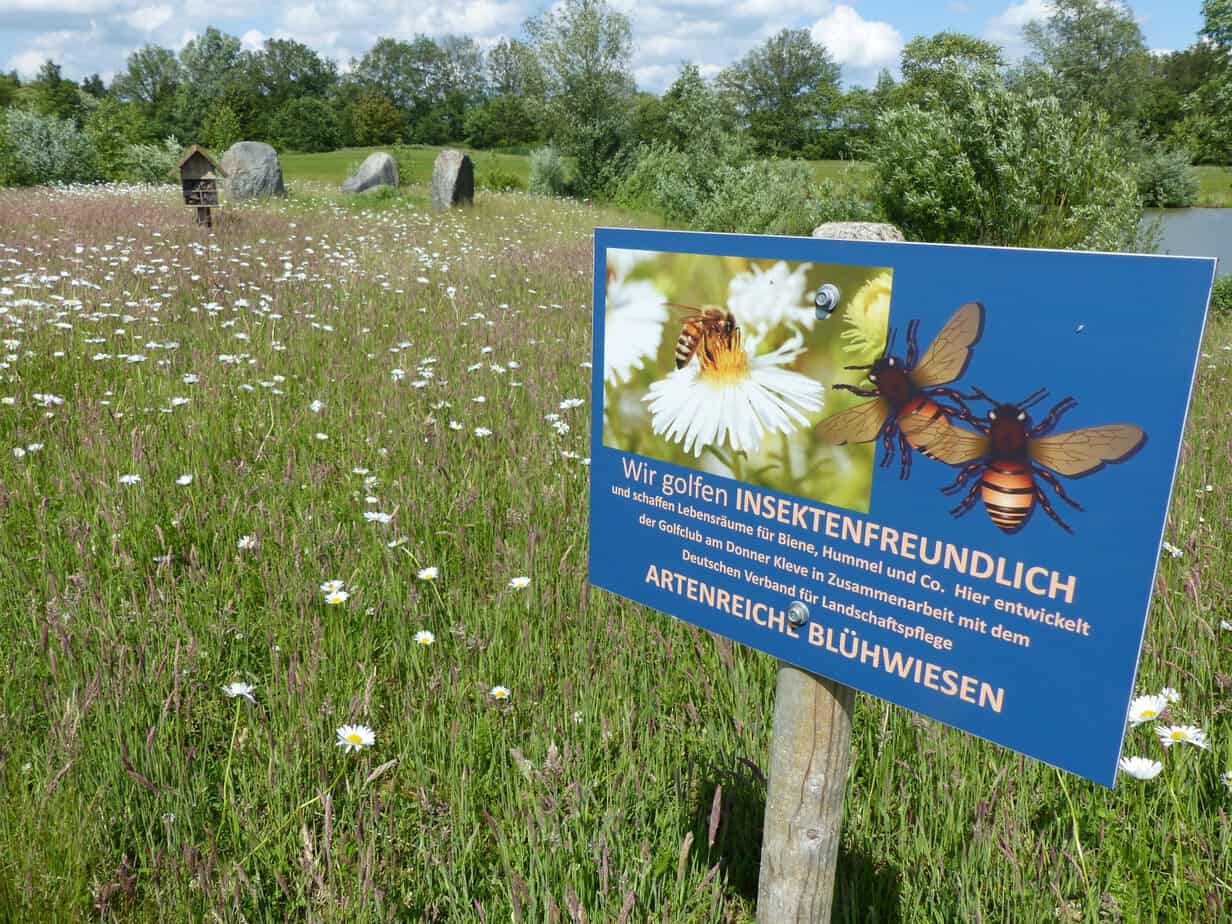Schleswig-Holstein: Funding opportunity for meadows
The goal is clear: “First of all, we want to create flowering meadows.” Dr. Kristina Steffen from the Schleswig-Holstein regional office of the German Association for Landscape Conservation is confident that this can be achieved on golf courses. After all, cooperation with golf courses has got off to a good start in recent years. With the program Blütenbunt-Insektenreich. Creating diversity together! four golf courses are already involved with the Mittelholsteinischer GC Aukrug, GC Hof Berg, GC Uhlenhorst and Golf am Donner Kleve, which have created new species-rich meadows. A new addition is the Golf-Club Gut Grambek, which wants to create species-rich areas together with the DVL in 2024.
Program runs until 2026
The “Blütenbunt-Insektenreich” project, in which golf courses can participate until 2026, is interesting for the clubs in several respects:
- The DLV not only selects the appropriate regional seeds in consultation with the club, but also finances them.
- At the same time, the DLV provides advice on the selection of suitable areas and, in consultation with the greenkeeper and the club managers, determines on site which areas are suitable for upgrading.
- The DLV also acts as an intermediary if special machinery is required to work the land that the club does not have.
- The club does not have to carry out any monitoring or reporting. This means that there is no need for extensive documentation.
- The only assurance from the golf course is that the upgraded area will be left as it is for a total of five years and will not be used for other measures.
For Kolja Hause, office manager of the Schleswig-Holstein Golf Association, the Blütenbunt-Insektenreich project is an excellent opportunity to simply get into the field of biodiversity without having any major prior knowledge, spending money or investing a huge amount of time. “We already have so many areas on our golf courses that go beyond the traditional golf courses, which we make available in the interests of environmental protection. At the same time, however, many of these areas can certainly be managed even better and we see a very good opportunity for cooperation here.”
Seeds from the neighborhood of the golf club
The example of the Gut Grambek Golf Club, which, according to Vice President Ingo Bernien, had previously only tried its hand at an annual flower meadow of around 500 square meters, but now wants to work with perennial meadows, shows how practical the cooperation can be. “In general, we have decided that we want to do more for biodiversity where we now have really large rough areas,” he summarizes.
In order to ensure the regionality of the seed, the golf course uses seed from a rough pasture from the municipality of Grambek, which was harvested in the fall of 2023. This seed is distributed over an area of around 2000 to 3000 square meters away from the golf courses. Head greenkeeper Christian Dunn, who is very interested in the further development of the topic of biodiversity, also pays attention to correct soil cultivation before sowing.
He is also interested in further cooperation with the DVL on the subject of heathland. Due to the sandy subsoil and the parkland structure, the Grambek site is ideal for sowing heathland. The golf course receives the mown grass from Grambeker Heide airfield, whose areas are mowed by the Nature Conservation Foundation, for transfer to Grambek. The Vice President is well aware that “we need patience here because heathland is developing very slowly.”
But that doesn’t deter Bernien at all. For him, it has long been clear that increasing cooperation with environmental and landscape associations is an integral part of the future of golf courses. “To date, many of us have taken the existing environment for granted, but we need to actively work on preserving or promoting it. That also means persuasion,” he explains. Because golfers also lose balls on the Grambek roughs and meadows and complain time and again about the grass being too high. Finding a good balance between the development of species-rich meadows and good playability is a fine art and a matter of course in the Lauenburg Lakes Nature Park.
Steffen then explains how important it is to select the right plants for these meadows using the wild bee, which “in some cases actually only has a flight time of four weeks.” Then, according to the expert, it is extremely important for the small insect to encounter plants that are flowering at the same time. “The regional seeds are precisely geared to the animal species present in the area, so that the wild bees can also find food.” If, on the other hand, the seed does not match the region, the wild bee is left empty-handed, at least on this golf course.
Biodiversity, she concludes, is therefore based on a very finely balanced interplay between the various players. For Kolja Hause from the Schleswig-Holstein Golf Association, this is the perfect opportunity for the golf clubs: “We can offer great areas and benefit from the expertise of the DLV. A classic win-win situation.”
More information about the program can be found here.








